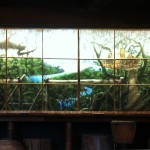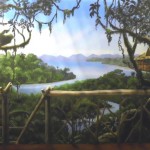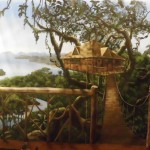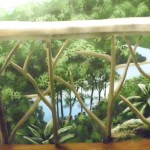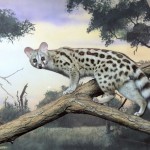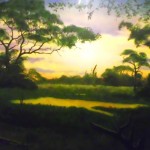In 2012 I spent a week working at the zoo in Erie, Pennsylvania, over the cusp of October into November. In size Erie has a relatively small zoo, but in quality, energy and ambition, Erie ranks with the best and biggest. For the first time, I was designing and supervising the building of a TV studio set.
I would also be painting murals for a new exhibit, so a lot of sketches, emails and design work preceded the trip.
The design concept was that of a large tree house serving as a wildlife research center in East Africa below Nairobi. I tried to design the set to make use of the mountain of burlap, woven panels, giant bamboo, barrels and sacks, rope and pulleys that my inner pack rat had plucked from the dumpsters of zoo, aquarium and Rainforest Cafe jobs and hoarded over the years. Not only was I contributing to a worthy cause, I would be reducing my bulk storage.
The project was named Kiboka Tree House, and it would be an extension of an existing exhibit, Kiboka Station, in a seven-sided building at the highest point in the Zoo’s topography. The second floor of the building had once been a hayloft to service the animals below. Now it would become the interior of a tree house that would turn the Swiss Family Robinson green with envy. From the tree house set, two of Erie’s staff members would be broadcasting weekly interactive animal programs to all schools in Pennsylvania.
Hurricane Sandy
I bought and installed a roof rack for my Volkswagen Jetta, and to it I lashed a 6-by-12 foot canvas on which I had painted a mural on my back porch. Alongside the rolled-up canvas were long packages of bamboo and other materials, lashed into a load weighing 162 pounds. The rack capacity was 165 lbs.
Alyce, my sounding board, detector-of-screwball-ideas and paramour, was co-pilot and navigator, a critical position since I tend to get distracted by telling stories like this while driving to, say, Milwaukee, and discover my error when I see the sign for the Iowa border up ahead.
The drive to Erie from Evanston, near Chicago, should have taken eight hours but we didn’t factor in Super Storm Sandy, with whom we collided halfway across Indiana. Because of the roof load, our aerodynamics and center of gravity were, um, challenging. The blinding rain was not as bad as the gusting wind. I felt like a school boy being shoved around by a bully. But the real bullies were the 18 wheelers that roared past us in the fast lane, the spray and bow wake nearly blowing us off the road. I imagined the drivers laughing maniacally.
After 11 hours, we arrived safely at the Zoo, which is nestled snugly in the valley of a winding stream that had become a turgid whitewater river from the heavy rains. I had done murals for Erie over a twelve-year span, and it was good to see familiar faces helping us unload: Zoo Director Cindy Kreider and Facilities Manager John Rhea, and some new faces including Tami Fowler, the on-screen educator.
We got the materials and mural upstairs, rolled out the plans and started work. After a few days, with a lot of effort by Tammy, John and his helpers, we had two side walls of heavy woven sisal carpeting with split bamboo battens, a plank floor, and heavy wooden beams supporting a camo mosquito-net ceiling, African masks hung alongside maps, hanging blocks and tackle, a water barrel fed by bamboo pipes, perimeter counter tops with stools beneath made of log sections, native drums, sacks and crates of supplies. In the center wall opposite the camera position was a wide window with bamboo mullions and camo curtains. Two feet beyond that, lit by hidden daylight-spectrum fluorescent lights, hung my mural. In the foreground is the rail of an outdoor deck made of rough tree branches, with the top of a ladder visible on the left. Looking through an opening in the giant shaggy branches, we see a distant lake and mountains, and another tree house in the near distance connected by a suspension bridge. The view over the treetops of the surrounding jungle creates the illusion of height.
I didn’t realize how successfully the mural had turned out until I saw the video clip of a local newscast in which I was interviewed through the window while standing on the non-existent deck. When I reach back and tap on the sky behind me, people watching the video often gasp in surprise. Makes my day!
Here’s a few photos, see also Erie Zoo Kiboka Tree House TV Studio.
Genets, Gorillas, and Guggenheim, Oh My
Before leaving Erie, I spent a few days painting an African savanna at twilight for a genet exhibit. I asked a few staffers what sort of an animal an African genet was. Most said, “Beats me, I guess we’ll know when they arrive.” Finally a senior keeper said, “Oh, a genet is a nocturnal mammal, sort of like a fossa.” Apparently I was unable to hide an expression of confounded ignorance because she added, “Sorta like a cross between a cat, a lemur and a fox.” I don’t think my expression changed, but her descriptive powers seemed to be exhausted because she just looked at me with thinly disguised pity and walked away.
One of the small joys of the trip was seeing an old girlfriend, Samantha, an African lowland gorilla, who had a cold and was looking old and disheveled. For my tribute to Samantha, who died two months later, see Sam.
The drive back to Chicago stood in stark contrast with the drive out. We took a side trip to see Frank Lloyd Wright’s masterpiece, Fallingwater, in a forest in southwestern Pennsylvania. I’ve been a Wright fan since seeing the Guggenheim Museum in New York as a teenager. The house was smaller and more intimate than pictures seemed to show, leading me to realize again, as I do each time I tour a Wright creation, that nothing can impart the sensation one gets by physically being inside the spaces. They create in me a serene, transporting, Shangri-La state of mind. If everyone lived in such a space I think we’d have world peace overnight and nothing to report on the evening news. But I console myself with the thought that contentment might be sort of boring.
